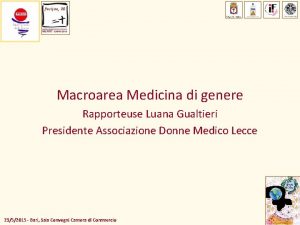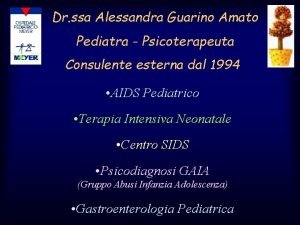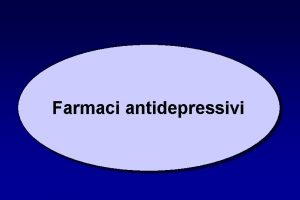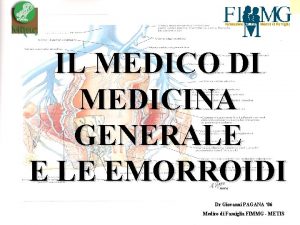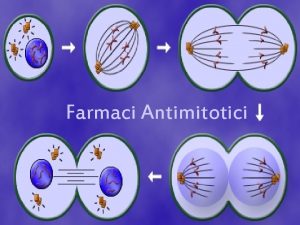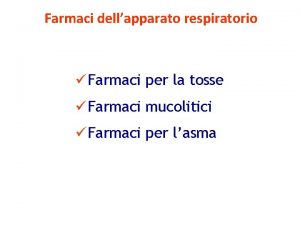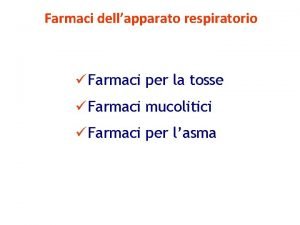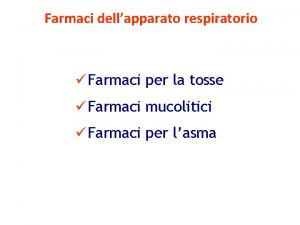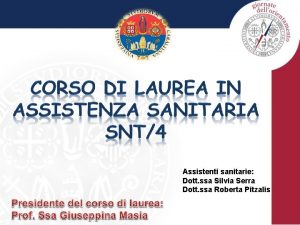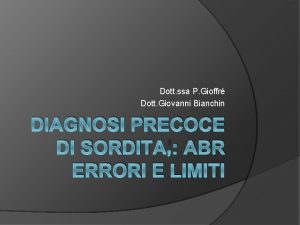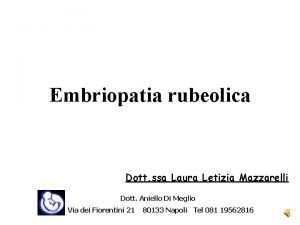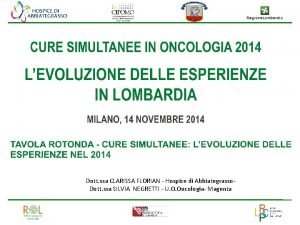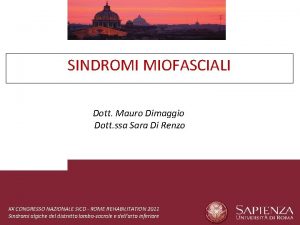ATASSIA DA FARMACI Dott ssa Rita Rinaldi UO
























- Slides: 24

ATASSIA DA FARMACI Dott. ssa Rita Rinaldi UO di Neurologia Azienda Ospedaliero-Universitaria S. Orsola-Malpighi Bologna

• Cerebellar ataxia • Sensory ataxia: myelopathy and/or neuropathy • Vestibular ataxia (vertigini e disequilibrio) The three types of ataxia have overlapping causes, and therefore can either coexist or occur in isolation.










Neurology. 1989 Mar; 39(3): 432 -3. Cerebellar atrophy following acute intoxication with phenytoin. Masur H 1, Elger CE, Ludolph AC, Galanski M. Author information Abstract A patient developed marked cerebellar atrophy after a single suicidal intoxication with 7 grams phenytoin. The clinical signs of cerebellar dysfunction subsided very slowly and incompletely within 18 months. We documented the cerebellar atrophy by CTs 4 weeks and 1 year after the intoxication, and we suggest that a single severe acute intoxication with phenytoin may directly cause cerebellar degeneration.


FARMACOCINETICA DELLA FENITOINA 90% alle proteine plasmatiche (albumina). Solo la parte libera è attiva. Metabolizzata dal citocromo P 450 • Ipoalbuminemia • Interazioni farmacologiche: tutti i farmaci che inibiscono il citocromo P 450 aumentano i livelli plasmatici della fenotoina (amiodarone, cimetidina, cotrimossazolo, disulfiram, fluconazolo, isradipina, metronidazolo, miconazolo, antidepressivi, 5 -fluoro-uracile, sulfonamidi)



Clin J Oncol Nurs. 2010 Jun; 14(3): 371 -3.


ATASSIA SENSITIVA (MIELOPATIA CON O SENZA NEUROPATIA )

February 2015 - Volume 21 - Issue 1, Spinal Cord Disorders - p 84– 99 Review Articles Metabolic and Toxic Causes of Myelopathy Goodman, Brent P. MD Summary: Deficiencies of vitamin B 12, folate, copper, and vitamin E may result in characteristic clinical, electrodiagnostic, and imaging features. Prompt recognition and treatment is critical to limit permanent neurologic impairment. Recognition of the toxic causes of myelopathy, including nitrous oxide exposure, heroin, radiation, various chemotherapeutic agents, liver disease, konzo, lathyrism, and zinc excess, is aided by understanding the typical clinical and imaging features associated with these agents.

Arch Surg. 1993; 128(12): 1391 -1395. Neurologic Degeneration Associated With Nitrous Oxide Anesthesia in Patients With Vitamin B 12 Deficiency Teresa S. Flippo, MD; Walter D. Holder Jr, MD BMJ Case Reports 2013; doi: 10. 1136/bcr-2012 -008509 Subacute combined degeneration of the spinal cord following recreational nitrous oxide use Hui Mei Cheng, Jae Hong Park, David Hernstadt Am J Health Syst Pharm. 2015 Jun 1; 72(11): 952 -7. doi: 10. 2146/ajhp 140583. Subacute combined degeneration of the spinal cord in a patient abusing nitrous oxide and self-medicating with cyanocobalamin. Pugliese RS 1, Slagle EJ 2, Oettinger GR 2, Neuburger KJ 2, Ambrose TM 2

N 2 O exerts its harmful effects by irreversibly oxidising the cobalt ion of cobalamin (vitamin B 12). Oxidation of the cobalt ion by N 2 O inhibits methylcobalamin as a cofactor of methionine synthase in the production of methionine and subsequently Sadenosylmethionine, which is necessary for methylation of myelin sheath phospholipids. Abuse of N 2 O has been previously reported in the literature among healthcare workers, such as dentists, as well as young adults who use the drug more frequently. Despite its purportedly high-rate of usage, serious side-effects as a result of itsabuse remain uncommon, with less than 20 cases reported in the literature.


Copper deficiency can occur after some pharmacological treatment with anti-copper drugs such as penicillamine (Wilson's disease therapy), and tetrathiomolybdate (anticancer and Wilson's disease therapy) Reduction in cytochrome oxidase activity may be the likely basis for neurological dysfunction associated with the copper deficient state.
 Rita rinaldi neurologia
Rita rinaldi neurologia Dott ssa luana gualtieri lecce
Dott ssa luana gualtieri lecce Dott ssa alessandra muliere
Dott ssa alessandra muliere Adjektivkomposita
Adjektivkomposita Monika hengge
Monika hengge Circolo portale ipotalamo ipofisario
Circolo portale ipotalamo ipofisario Dott ssa amato pediatra
Dott ssa amato pediatra Dott.ssa lucia lospalluti
Dott.ssa lucia lospalluti Dott ssa übersetzung
Dott ssa übersetzung Dott.ssa deutsch
Dott.ssa deutsch Dott.ssa deutsch
Dott.ssa deutsch Dott ssa elena bozzola
Dott ssa elena bozzola Dott ssa benilde cosmi bologna
Dott ssa benilde cosmi bologna Dott.ssa deutsch
Dott.ssa deutsch Chiara giugliano
Chiara giugliano Veronika körner
Veronika körner Silvia consorti
Silvia consorti Ivano dones
Ivano dones Atassia cerebellare
Atassia cerebellare Atassia frontale di bruns
Atassia frontale di bruns Neuroplasticità
Neuroplasticità Farmaci ipolipidemizzanti cosa sono
Farmaci ipolipidemizzanti cosa sono Venotropi
Venotropi Microtubuli
Microtubuli Glicosidi cardioattivi
Glicosidi cardioattivi

